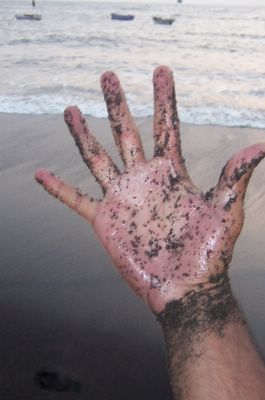Rajasthan. The land of the Kings. My stay here for last three months were quite eventful. The vast expanses of the waste lands, and miles of sand is a visual treat. For me this clocks over 7000 kms of traveling over the last 6 months.
Living in the desert as a villager is totally different than the kind of life that we are so used to in the fertile regions of our country. The villages are small with 10 to 20 houses and large families. Water is scarce and the villagers most usually depend on the rains. They actually have a unique style of water storage and filtration. They dig sumps of about 20 ft with a dia of about 5 ft. lined with loose cement, they take about 6-7 hours to dig at the rate of Rs 300-400 per hour. The beat the earth around the sump to settle the sand. The sump then collects whatever rainfall it can. The sump reaches its peak efficiency only after a couple of rains. The water is stored in about 10 to 20 sumps per village. The water stored for over a year turns brackish and develops a layer of algae over it. The villagers, when require water, take the water and filter it in their homes and drink it. They prefer it to the salty ground water in most places.
There is practically no mobile coverage. Each village have atleast one PCO. Usually the only telephone for miles. Electricity is in cycles of 7 hours. There is power at 7 hour stretches. The timing is so that you have power for 7 hours in the day for a week then for 7 hours in the night for a week. Ofcourse I am talking about the villages. In the cities it is slightly better. All the villages are well connected by road with vehicular traffic of atleast one bus per day. Its really amusing when you are driving for hours and suddenly a village pops out from nowhere.
They tell me that Rajasthan is a lot greener from what it was about 10 years back, all thanks to the Indira Gandhi Canal. You actually see a lot of greenery next to the canal. Its actually like that of a dense jungle. There was one thing that I found strange about the vegetation along the canal. The trees along the cannal is green, then there is a band of dead trees for about 25 mtrs all along the canal. The greenery then begins again. This is true for most of the vegetation along the canal. Nobody has a logical enough explanation for this.
We did a lot of traveling to all the forts and tourist areas we could get time to explore. One place that is noteworthy of mention is the Mehramgarh Fort in Jodhpur. It is a medium sized fort looming majestically over the town of Jodhpur. The fort was totally self sufficient when it was populated. The water supply system in the fort is interesting. Water is pulled up from tanks below the fort along the high walls. It is then poured over the turrets which have channels for the water, which inturn carry the water to the rest of the fort. There are many windows in the fort and the view from each window goes far and wide. The guns are still there pointing towards the vast expanse to protect the fort from its enemies. Though most of the range of the gun has been taken over by the population of the town. The fort boasts of a small museum within, with many an interesting artifact. There is a small coffee shop within the fort too, though the rates are exhoribant. A bottle of cheap wine for 1100 bucks. I have had better for cheaper. But then again it was agreat experience.
The people of Rajasthan, especially the villagers, are the most friendly that I have met. The children were particularly exited whenever they saw us Faujis. But something that really hit us was the prevalent caste system. One of my colleagues stopped by and chatted with a kid of about 10 years. The first thing that Naveen was asked was what his jaath was. One more time me and Naveen were sitting in our makeshift mess when this old villager walks by. We invite him to share our lunch with us. When the server gave him a plate he asks him what his caste is. That got us really irritated. We gave the old man a choice, take the food silently or take a kick. So much for our charity. But the people are really friendly. They allowed us to use their wells wherever we set up our camps. The have deep respect for the armed forces, something that is rare to come by. Civilians in the cities everywhere else look at you as if you are from a different planet altogether.
Some trivia that we came across during our stay in the wild wild west.
The erstwhile kings sometimes had 20-22 queens.
The temperatures are close to 50 in the day and around 10 in the nights.
Land is costly. The rates in Jaipur are about Rs 17000 per sq yd, the cheapest being Rs 7000 per sq yd
People are very colourful in their clothing. Their traditional linen is something called ‘bandhni’, hand dyed block printed clothing.
Things you should have if you plan to visit. An SUV, lots of water, lots of money for all the curiosities you will want to buy, warm clothing definitely if you visit during the winters… the best times being Oct-Nov or Feb-March and a world space receiver --- there is no FM.
Friday, April 22, 2005

The black sands of the beaches of Daman and Diu. We stopped by here on our drive through the Union Territory.

Subscribe to:
Comments (Atom)








